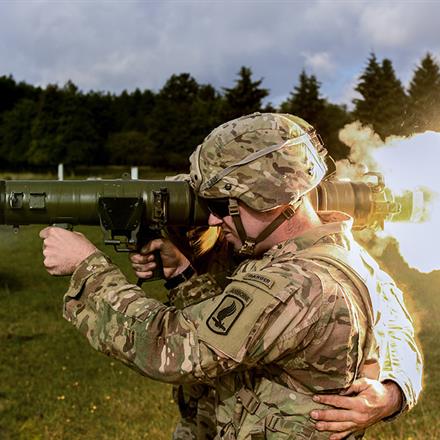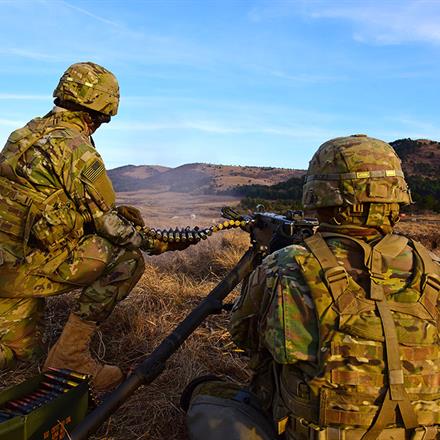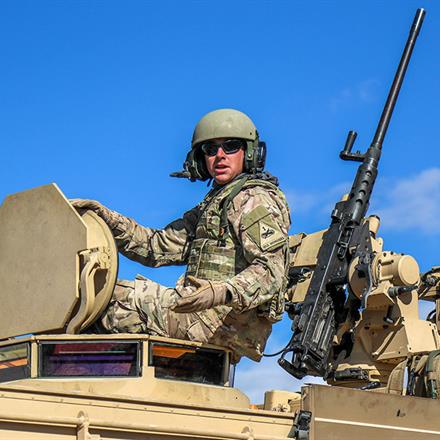Blast Overpressure
A sharp instantaneous rise in ambient atmospheric pressure resulting from an explosive detonation or the firing (i.e. operating) of weapons. Blast overpressure (BOP) is also known as non-auditory noise.
explosive detonation or the firing (i.e. operating) of weapons. Blast overpressure (BOP) is also known as non-auditory noise.
Data Requirements
Conduct BOP testing IAW the guidance in TIP 88-001-0411, ITOP 04-2-822, and TOP 04-2-831 1,2,3. Testing should use a validated blast test device (BTD) and represent all of the weapon system's occupied positions and operating conditions. After the test is completed, send properly formatted data and a test summary to the APHC for analysis using the Blast Overpressure Test Information Form found in TIP 88-001-0411. BOP testing is required when impulse noise testing yields an ANOR of less than or equal to 5.
Health Protection Criteria
Extensive study by the U.S. Army Medical Research and Development Command has yielded a biomechanical model describing the relationship between the intensity of a blast exposure and the risk of lung injury 4. This model resides within the BOP-HHA software used by the APHC. Due to the complexity of factors found in the blast environment and variations in the intensity and pulse duration of blast waves it is not possible to express blast overpressure injury risk as a simple numeric threshold value.
Impulse Noise
 A variation in air pressure above the average atmospheric pressure lasting <1 second in duration. Impulse noise is described quantitatively by the peak pressure level (in units of decibels, peak (dBP)), A-duration, and B-duration. The most common sources for impulse noise are the firing of weapons, detonation of explosives, rapid release of high-pressure gases, and impact of solid objects.
A variation in air pressure above the average atmospheric pressure lasting <1 second in duration. Impulse noise is described quantitatively by the peak pressure level (in units of decibels, peak (dBP)), A-duration, and B-duration. The most common sources for impulse noise are the firing of weapons, detonation of explosives, rapid release of high-pressure gases, and impact of solid objects.
Data Requirements
Collect impulse noise data IAW MIL-STD-1474D, TOP 01-2-608A, and ITOP 04-2-822 2,5,6. This includes at-ear measurements for each occupied positions (e.g., operators, passengers, crew, or maintenance personnel) and 140 dBP contour distance measurements. Assessments may be done by analogy with similar systems in lieu of obtaining data on a case-by-case basis. Provide the data, including a detailed use scenario (e.g., anticipated exposure, firing position, firing conditions), to the APHC to support the completion of a definitive HHA.
Health Protection Criteria
The U.S. Army considers impulse noise levels of ≥140 dBP hazardous 7,8,9. Repeated, unprotected exposure to hazardous impulse noise may cause permanent hearing loss.
Steady-state Noise
A variation in air pressure, exceeding one second in duration, around the ambient atmospheric pressure; commonly measured in decibels, A-weighted (dBA). The frequency range considered in the evaluation of steady-state noise is 20 hertz to 20 kilohertz. Steady-state noise can be continuous, intermittent, or fluctuating.
the ambient atmospheric pressure; commonly measured in decibels, A-weighted (dBA). The frequency range considered in the evaluation of steady-state noise is 20 hertz to 20 kilohertz. Steady-state noise can be continuous, intermittent, or fluctuating.
Data Requirements
For equipment that may produce hazardous noise, collect steady-state noise data IAW MIL-STD-1474E and TOP 01-2-608A 6,7. This includes source measurements, 85 dBA contour distance measurements, and at-ear measurements for each occupied position (e.g., operators, passengers, crew, or maintenance personnel) during each normal operating mode. Provide the data, including a detailed use scenario (e.g., anticipated exposure duration), to the APHC to support the completion of a definitive HHA.
Health Protection Criteria
The U.S. Army considers steady‑state noise levels of ≥85 dBA for any length of time hazardous 7,8,10. Repeated, unprotected exposure to hazardous impulse noise may cause permanent hearing loss.
For more information and guidelines for assessing acoustic energy health hazards, see Technical Guide 351A, Health Hazard Assessor's Guide, Volume 1: Acoustic Energy.
References
(1) U.S. Army Public Health Center, Technical Information Paper No. 88-001-0411.
(2) ATEC. 2000. International Test Operations Procedure (ITOP) 04-2-822, Electronic Measurement of Air Blast Overpressure and Impulse Noise.
(3) ATEC. 2008. Test Operations Procedure (TOP) 04-2-831, Use of Blast Test Device (BTD) During Auditory Blast Overpressure Measurement. 
(4) Stuhmiller JH. 1996. A Health Hazard Assessment for Blast Overpressure Exposures-Biological Response to Blast Overpressure: A Summary of Modeling. Jaycor Technical Report No. J96-2997-01/034. Prepared for the U.S. Army Medical Research and Materiel Command, Fort Detrick, Maryland. 
(5) DOD. 1997. MIL-STD-1474D. Department of Defense Design Criteria Standard: Noise Limits. 
(6) ATEC. 2011. Test Operations Procedure (TOP) 01-2-608A, Sound Level Measurements. 
(7) DOD. 2015. MIL-STD-1474E. Department of Defense Design Criteria Standard: Noise Limits. 
(8) DA. 2015. Pamphlet 40-501, The Army Hearing Program. 
(9) Memorandum, APHC, Army Hearing Program, MCHB-IP-MAH, Subject: Interim Impulse Noise Damage Risk Criterion, 2020. APG, MD.
(10) Department of the Army (DA). 2020. Regulation 40-5, Army Public Health Program. 
